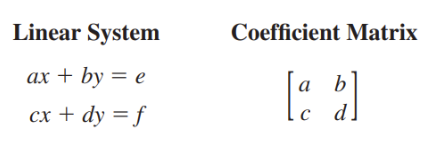Matrices
Lesson 1: Basic Matrix Operations
Adding and Subtracting Matrices
A matrix is a rectangular arrangement of numbers
The dimensions of a matrix with m rows and n columns are m × n (read "m by n")
The numbers in a matrix are its elements
Two matrices are equal when their dimensions are the same and the elements are equal
To add or subtract two matrices, add or subtract their corresponding elements
Add or subtract matrices only when they have the same dimensions

Scalar Multiplication
When working with matrices, a real number is called a scalar
To multiply a matrix by a scalar, multiply each element in the matrix by the scalar
This is called scalar multiplication
Scalar Matrix Equations
Using the definition of equal matrices, you can equate the elements in corresponding portions of two matrices that are equal
Lesson 2: Multiplying Matrices
Multiplying Matrices
The product of two matrices A and B is defined provided the number of columns in A is equal to the number of rows in B
If A is an m × n matrix and B is an n × p matrix, then the product AB is an m × p matrix

To find the element in the ith row and jth column of the product matrix AB, multiply each element in the ith row of A by the corresponding element in the jth column of B, then add the products

Matrix multiplication is not commutative

Lesson 3: Matrix Determinants and Cramer's Rule
The Determinant of a Matrix
Determinant of a 2x2 Matrix
The determinant of a 2x2 matrix is the difference of the products of the elements on the diagonals shown

Determinant of a 3x3 Matrix
Repeat the first two columns to the right of the determinant
Subtract the sum of the red products from the sum of the blue products

Cramer's Rule
You can use determinants to solve a system of linear equations
The method, called Cramer's Rule, uses the coefficient matrix of the linear system

Cramer's Rule for a 2x2 System
Let A be the coefficient matrix of the linear system

If det A ≠ 0, then the system has exactly one solution:

Note that the numerators for x and y are the determinants of the matrices formed by replacing the values of the x and y coefficient columns, respectively, with the columns of the constant values
Cramer's Rule for a 3x3 System
Let A be the coefficient matrix of the linear system shown below

If det A ≠ 0, then the system has exactly one solution:

Lesson 4: Inverse Matrices
Finding Inverse Matrices
The n x n identity matrix is a matrix with ones for all elements on the main diagonal (top left to bottom right) and zeros for all the other elements
If A is any n x n matrix and I is the n x n identity matrix, then AI = A and IA = A

Two n x n matrices A and B are inverses of each other when their product is the n x n identity matrix; AB = I and BA = I
An n x n matrix A has an inverse if and only if det A ≠ 0
The inverse of A is denoted by A-1
The Inverse of a 2x2 Matrix

Using an Inverse Matrix to Solve a Linear System
Write the system as a matrix equation AX = B; the matrix A is the coefficient matrix, X is the matrix of variables, and B is the matrix of constants
Find the inverse of matrix A
Multiply each side of AX = B by A-1 on the left to find the solution X = A-1B
 Knowt
Knowt
